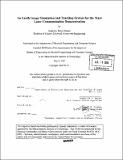An earth image simulation and tracking system for the Mars Laser Communication Demonstration
Author(s)
Balster, Stephanie Karen
DownloadFull printable version (6.306Mb)
Other Contributors
Massachusetts Institute of Technology. Dept. of Electrical Engineering and Computer Science.
Advisor
Frederick K. Knight and Dennis M. Freeman.
Terms of use
Metadata
Show full item recordAbstract
In this thesis I created an Earth-image simulation and investigated Earth-tracking algorithms for the Mars Laser Communication Demonstration (MLCD). The MLCD mission will demonstrate the feasibility of high-data-rate laser communications between a Mars orbiting satellite and an Earth ground station. One of the key challenges of the mission is the requirement to achieve 0.35-rad-accuracy pointing and tracking of the laser beam to maintain the 1-30 Mbps communication downlink from Mars to Earth. The sunlit Earth is a bright source and, for most of the mission, can be tracked to stabilize the telescope from disturbances between 0.02 to 2 Hz, while other stabilization systems will cover the rest of the frequency spectrum. Before testing candidate Earth-tracking algorithms, simulated Earth image sequences were created to provide test; data sets. While a plain centroiding algorithm, thresholded-centroiding algorithm, cross-spectrum phase correlation method, and optical flow algorithm were all tested under various Earth phase conditions and pixel resolutions to evaluate their performance on simulated test data, the thresholded-centroiding algorithm was eventually chosen for its accuracy and low computational cost. The effect of short-term albedo variations on the performance of the thresholded-centroiding algorithm was shown to be limited by the Earth's rotation and too slow to change the Earth's surface enough to affect the centroid calculation between time frames. Differences between the geometric centroid and optical centroid were measured to be up to 10% of the Earth's diameter, or up to 2 focal plane array pixels during the mission at closest range. As such, the uncertainty area in which to search for the beacon at the ground receiving station is limited to a 2-pixel radius.
Description
Thesis (M. Eng.)--Massachusetts Institute of Technology, Dept. of Electrical Engineering and Computer Science, 2005. Includes bibliographical references (p. 71-72).
Date issued
2005Department
Massachusetts Institute of Technology. Department of Electrical Engineering and Computer SciencePublisher
Massachusetts Institute of Technology
Keywords
Electrical Engineering and Computer Science.